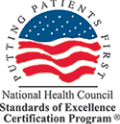Alpha-1 and other plasma consumers worked with the Department of Health and Human Services (HHS) and the plasma industry over the past year to launch a blood & plasma donation awareness campaign, the funding for which was established under the Coronavirus Aid, Relief, and Economic Security (CARES) Act of 2021. Initially, the campaign was only going to include whole blood donation. The Alpha-1 Foundation was proud to have been part of this advisory committee that will make a difference in the lives of many patients including Alphas.
Giving = Living was created to save lives following the impact of the COVID-19 pandemic
Our nation’s blood and plasma supply dropped to historic lows during the COVID-19 pandemic. While some areas of the country have seen improvement, other areas are still struggling to meet the demand. Blood and plasma are needed on an ongoing basis to treat a variety of life-threatening conditions, which is why the U.S. Department of Health and Human Services (HHS), is launching a new campaign, Giving = Living.
The campaign aims to increase awareness of the importance of donating blood and plasma and to encourage Americans to create new, regular donation habits. Every two seconds, someone in the United States needs blood for surgeries, cancer treatments, childbirth, anemia, serious injuries, and blood disorders. For many people, receiving a blood transfusion is lifesaving. Similarly, patients with rare diseases rely on medical treatments every day that are only available when people roll up their sleeves and give source plasma.
“A consistent supply of blood and plasma is critical to the health of our nation,” said HHS Assistant Secretary for Health Admiral Rachel L. Levine, MD. “There is no replacement for human blood and plasma. We simply need more people to give and to give regularly. We also need donors from diverse ethnic and racial backgrounds.”
Diversity in the blood supply is important because certain blood types are unique to specific groups. Blood from a donor of a similar ethnic background is less likely to be rejected by a patient and often results in fewer complications after a transfusion. In addition, some people have rare blood types and need transfusions of compatible blood. Having a large, diverse pool of blood donors ensures that all patients will have access to the blood they need, when they need it. Despite this, America’s Blood Centers estimates that less than 20 percent of all blood donations currently come from communities of color.
The campaign, funded through the Coronavirus Aid, Relief, and Economic Security (CARES) Act, features personal stories of people who benefit from donations:
- Heather of Dallas-Ft. Worth, Texas is an individual living with sickle cell disease who has had multiple blood transfusions and has had to wait, sometimes days, for lifesaving blood to become available. She depends on many people who give blood.
- Earl of Scranton, Pa. was badly wounded by a roadside bomb in Afghanistan, which led to massive blood loss and a need to have his leg amputated. He survived because of several blood transfusions.
- Alice of Houston, Texas requires a plasma-based therapy to treat a rare disease called common variable immunodeficiency. This therapy helps to replace the antibodies her body should be making and is essential to her survival.
- Crystal of Birmingham, Ala. is a wife and mom of two boys who was diagnosed with two neuromuscular autoimmune conditions that resulted in her going from being totally independent to suddenly being unable to feed, bathe, or dress herself. While there is no cure for her condition, plasma-based treatments and a healthier lifestyle are helping her regain her mobility.
Organizations from across the blood and plasma industries were instrumental in creating this campaign.
Visit hhs.gov/givingequalsliving to learn more about the importance of donation and make an appointment at a donation location near you.











